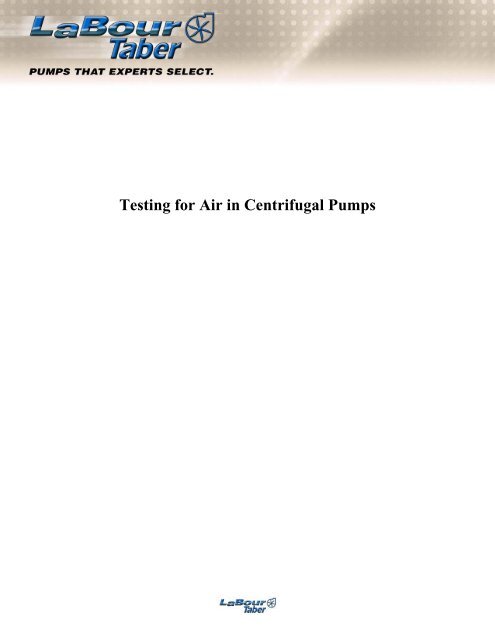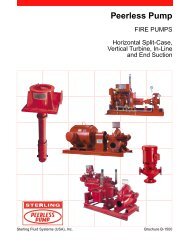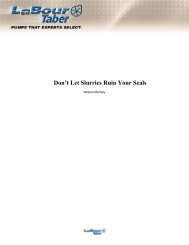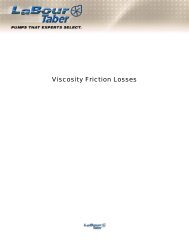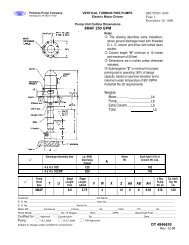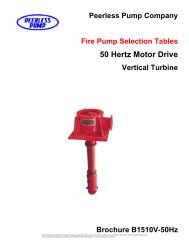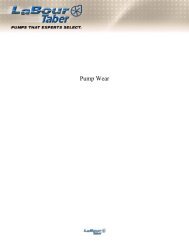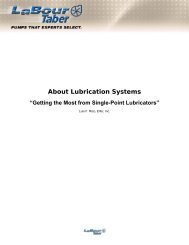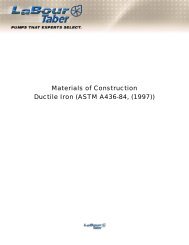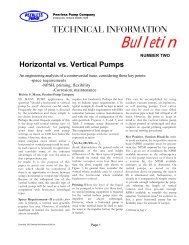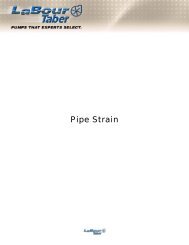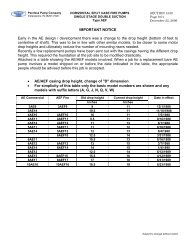Testing for Air in Centrifugal Pumps.pdf - Peerless Pump
Testing for Air in Centrifugal Pumps.pdf - Peerless Pump
Testing for Air in Centrifugal Pumps.pdf - Peerless Pump
You also want an ePaper? Increase the reach of your titles
YUMPU automatically turns print PDFs into web optimized ePapers that Google loves.
<strong>Test<strong>in</strong>g</strong> <strong>for</strong> <strong>Air</strong> <strong>in</strong> <strong>Centrifugal</strong> <strong><strong>Pump</strong>s</strong>
The amount of air that can be handled with reasonable pump life varies from pump to pump. However, <strong>in</strong> nocase is it to be expected that a pump will give better life with air present than it would if the liquid were entirelyair-free. The elim<strong>in</strong>ation of air has greatly improved the operation and life of many troublesome pumps. Whentrouble occurs, it is common to suspect everyth<strong>in</strong>g but air, and to consider air last, if at all.If air is present, the pump is likely to operate with a certa<strong>in</strong> amount of <strong>in</strong>ternal noise. This noise can bedescribed as “gravel noise”- sounds very much as though the pump were handl<strong>in</strong>g water full of gravel. This isthe same type of noise generally associated with cavitation.In many cases mak<strong>in</strong>g a simple test <strong>for</strong> the presence of air can save a great deal of time, <strong>in</strong>convenience, andexpense. We will assume that calculations have already been made to assure that the NPSH available is greaterthan that required by the pump (the noise is not a result of cavitation). The next step should be to check <strong>for</strong> thepresence of entra<strong>in</strong>ed air <strong>in</strong> the suction.When the source of suction supply is below the centerl<strong>in</strong>e of the pump, check <strong>for</strong> the conditions coveredpreviously <strong>in</strong> this manual.When the source of suction supply is above the centerl<strong>in</strong>e of the pump, a check <strong>for</strong> air leaks can be made bcollect<strong>in</strong>g a sample <strong>in</strong> a “bubble bottle” as illustrated <strong>in</strong> Figure 12. S<strong>in</strong>ce the pressure at the suction chamber ofthe pump is above atmospheric pressure, a valve can be <strong>in</strong>stalled <strong>in</strong> one of the tapped open<strong>in</strong>gs at the high po<strong>in</strong>t<strong>in</strong> the chamber and liquid can be fed <strong>in</strong>to the “bubble bottle.” The presence of air or vapor will show itself <strong>in</strong> the“bubble bottle.”Obviously the next step is to elim<strong>in</strong>ate the source of air s<strong>in</strong>ce quantities present <strong>in</strong> sufficient amount to beaudible are almost certa<strong>in</strong> to cause premature mechanical failure.Connect to valve<strong>in</strong>stalled at the high po<strong>in</strong>t<strong>in</strong> the suction chamberFigure 12LaBour <strong>Pump</strong> Company – 901 Ravenwood Drive, Selma, Alabama 36701Ph: (317) 925-9661 - Fax: (317) 920-6605 - www.labourtaber.comA Product of <strong>Peerless</strong> <strong>Pump</strong> CompanyCopyright © 2005 <strong>Peerless</strong> <strong>Pump</strong> Company


